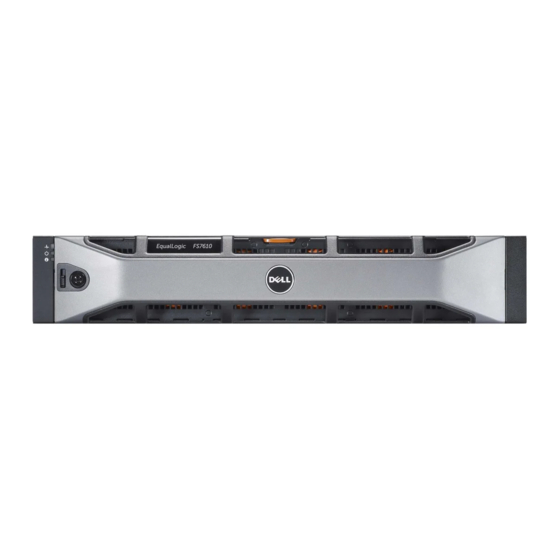Dell EqualLogic FS7610 Посібник зі встановлення та налаштування - Сторінка 25
Переглянути онлайн або завантажити pdf Посібник зі встановлення та налаштування для Зберігання Dell EqualLogic FS7610. Dell EqualLogic FS7610 46 сторінок. Appliances
Також для Dell EqualLogic FS7610: Огляд (7 сторінок), Посібник користувача обладнання (32 сторінок)

Dell EqualLogic FS7610 Installation and Setup Guide
The Dell FS7610 has the following types of networks:
•
Client network—Enables the system to connect to your user clients for file data access.
•
SAN/internal network—Enables internal communication between the controllers required for failover and
heartbeat, and communication between the controllers and the EqualLogic PS Series SAN for storing user
data. The SAN/internal network is connected to the same set of Ethernet switches.
Ideally, you want a network switch configuration in which a switch failure does not disrupt the availability of the
NAS cluster. That is, no single switch should have all the client, SAN, or internal network connections.
Requirements and Recommendations for Each Appliance:
•
Optical or twin-axial cables, or copper cables for 10GBASE-T: You need 10 network cables for the FS7610
NAS appliance (see
•
If you rack and cable the FS7610 system yourself, follow the cabling diagram and instructions in
Connecting Network Cables on page
topology for both your SAN/internal and client networks.
•
Connect the SAN/internal network ports on each network interface card (NIC) to different switches (see
Figure
9).
•
Use separate switches for the client network than for the SAN and internal network.
•
Use separate subnets for the client network than for the SAN and internal network.
•
The client network should be redundant and configured for highavailability. Flow control is not required, but
Dell recommends using flow control on the client switches.
If you change the default load balancing to LACP or if you use standalone switches, they must be
stacked.
•
The client network on the FS7610 is set to 1500 MTU by default. However, you can modify the setting on
client network switches to enable jumbo frames if required.
Requirements for the SAN/Internal Network:
•
Enable flow control on the switches and network interfaces for the SAN/internal network.
•
Disable Unicast storm control on the SAN/internal switches. You can use VLANs, but they are not required.
If you use VLANs on your switches, the SAN and internal networks must be in the same VLAN.
•
Jumbo frames are required on the SAN/internal network. Enable jumbo frames (to support a frame size of
9000 bytes) on the SAN/Internal network switches. Note that Dell PowerConnect switches must be
configured to 9216 MTU. Switches from vendors other than Dell might require a different MTU
configuration to accept frames of 9000 bytes.
•
Do not block IPv6 traffic on your SAN/internal switches.
•
Disable IGMP and/or MLD snooping on the switch ports to which the SAN/internal ports of the FS7610 are
connected. Refer to your switch manual for instructions on disabling IGMP/MLD snooping on the
SAN/internal switch.
•
Do not use a router between the NAS appliance and the PS Series arrays.
Table
4).
20. Dell strongly recommends using a highly available network
4 Network Cable Connections
Steps for
19
